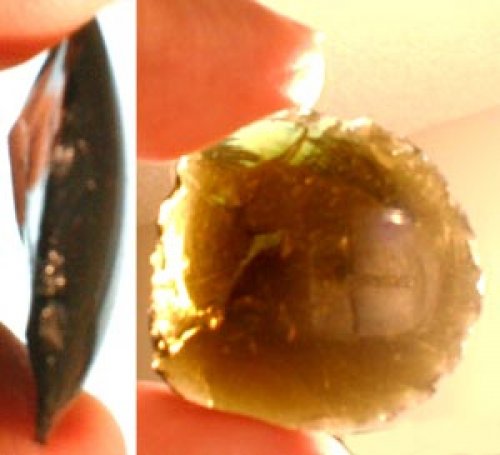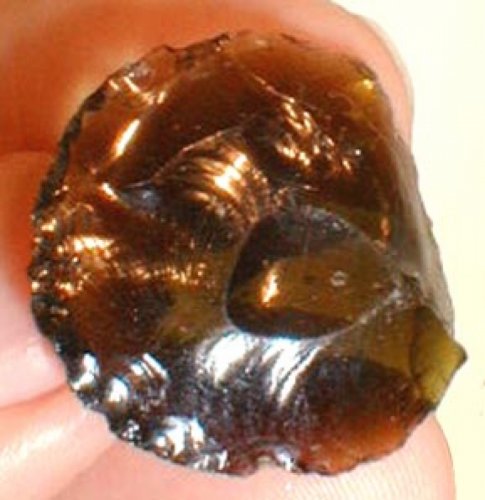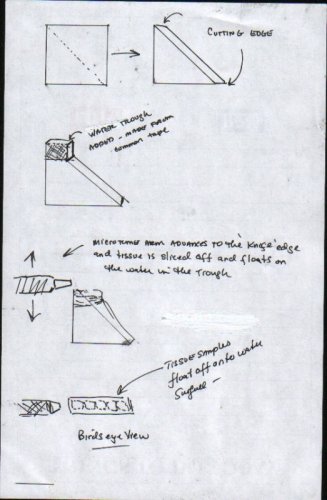Harry Pristis
Well-Known Member
This is an interesting use for a broken bottle.
Below is a pic of a "thumbnail" scraper made from the shoulder of a black glass bottle. ("Scraper" understates the effectiveness of this razor-sharp tool.) There are tiny pressure flakes from use around the edge of the tool.
This is an "Indian" artifact found while poking around the area of a fort built adjacent to a Seminole Indian settlement. The Seminoles had taken over the site of an aboriginal Timucuan Indian town.
The aboriginal town, called Cuscowilla, is located in Northcentral Florida. By 1710, Cuscowilla was in decline as a result of disease, slave raids, and war between Spanish and English. There are no more Timucuans.
At the same time, Creek Indians fleeing the British in Georgia and South Carolina began moving into North Florida. The Indians and runaway slaves (who were fleeing everyone) coalesced into a new group dubbed "Seminoles."
By the time the United States bought Florida in 1818, the townsite of Cuscowilla hosted a significant settlement of Seminoles.
In 1821 a fort was built near the Seminole settlement to keep the Indians pacified. (A series of Seminole Wars broke out anyway.)
Indian artifacts made from bottle-glass are usually referred to the Seminole period, but it is difficult to date such a tool when found out of context (this was a surface find in a kitchen garden).
Judging from the contour, this glass came from the shoulder of a cylinder bottle. This could indicate an age of anywhere from 1740.
The best guess, though, is that the bottle-glass dates to the fort period 1820s to 1840s. The fort would have had a suttler's store, and black glass bottles would have been readily available.
For perspective, it is much easier to find a 5,000 year old spear-point in Florida than it is to find a Seminole artifact from the early period.
---------Harry Pristis

Below is a pic of a "thumbnail" scraper made from the shoulder of a black glass bottle. ("Scraper" understates the effectiveness of this razor-sharp tool.) There are tiny pressure flakes from use around the edge of the tool.
This is an "Indian" artifact found while poking around the area of a fort built adjacent to a Seminole Indian settlement. The Seminoles had taken over the site of an aboriginal Timucuan Indian town.
The aboriginal town, called Cuscowilla, is located in Northcentral Florida. By 1710, Cuscowilla was in decline as a result of disease, slave raids, and war between Spanish and English. There are no more Timucuans.
At the same time, Creek Indians fleeing the British in Georgia and South Carolina began moving into North Florida. The Indians and runaway slaves (who were fleeing everyone) coalesced into a new group dubbed "Seminoles."
By the time the United States bought Florida in 1818, the townsite of Cuscowilla hosted a significant settlement of Seminoles.
In 1821 a fort was built near the Seminole settlement to keep the Indians pacified. (A series of Seminole Wars broke out anyway.)
Indian artifacts made from bottle-glass are usually referred to the Seminole period, but it is difficult to date such a tool when found out of context (this was a surface find in a kitchen garden).
Judging from the contour, this glass came from the shoulder of a cylinder bottle. This could indicate an age of anywhere from 1740.
The best guess, though, is that the bottle-glass dates to the fort period 1820s to 1840s. The fort would have had a suttler's store, and black glass bottles would have been readily available.
For perspective, it is much easier to find a 5,000 year old spear-point in Florida than it is to find a Seminole artifact from the early period.
---------Harry Pristis






